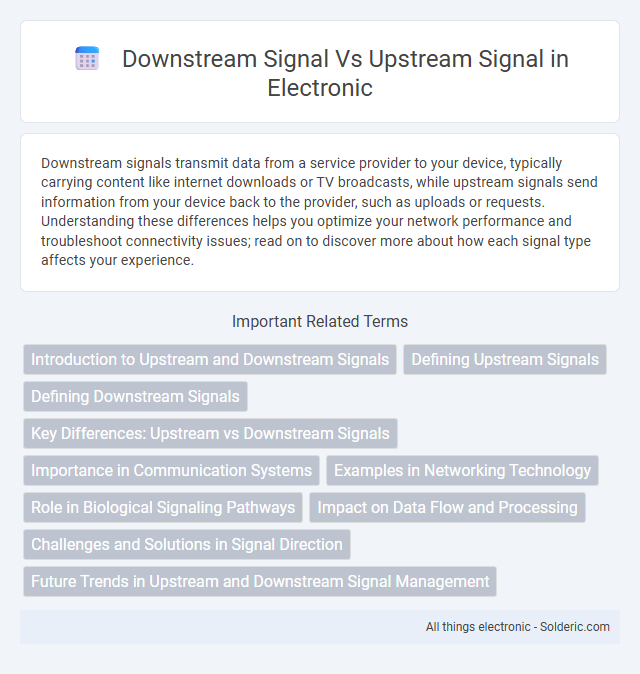Downstream signals transmit data from a service provider to your device, typically carrying content like internet downloads or TV broadcasts, while upstream signals send information from your device back to the provider, such as uploads or requests. Understanding these differences helps you optimize your network performance and troubleshoot connectivity issues; read on to discover more about how each signal type affects your experience.
Comparison Table
| Aspect | Downstream Signal | Upstream Signal |
|---|---|---|
| Definition | Signal sent from the central network to the user device | Signal sent from the user device to the central network |
| Direction | Network - User | User - Network |
| Typical Speed | Higher (e.g., download speeds) | Lower (e.g., upload speeds) |
| Purpose | Deliver content, updates, streaming media | Send user data, requests, commands |
| Examples | Video streaming, browsing, file downloads | Email sending, file uploading, live broadcasting |
| Latency Sensitivity | Moderate | High (real-time communications) |
Introduction to Upstream and Downstream Signals
Downstream signals refer to data transmissions sent from a central source, such as an internet service provider, to your device, carrying content like video streams, web pages, and downloads. Upstream signals, conversely, represent data sent from your device back to the source, including actions like uploading files, sending emails, and requests for information. Understanding the role of upstream and downstream signals is crucial for optimizing network performance and ensuring efficient two-way communication.
Defining Upstream Signals
Upstream signals refer to the data sent from your device back to the network, like uploading files or sending requests. These signals travel from subscriber equipment to service providers, enabling two-way communication in cable and broadband networks. Understanding upstream signals is crucial for optimizing upload performance and maintaining efficient network traffic flow.
Defining Downstream Signals
Downstream signals refer to data transmissions sent from a central system, such as an internet service provider (ISP), to end users or devices in a network. These signals carry information like web content, video streams, and file downloads, flowing from the internet backbone toward consumer hardware. Understanding downstream signal characteristics is crucial for optimizing network performance and ensuring efficient data delivery.
Key Differences: Upstream vs Downstream Signals
Downstream signals transmit data from the service provider to the user, typically carrying content like video streams or web pages, whereas upstream signals carry data from the user back to the provider, such as requests or uploads. Downstream transmission generally offers higher bandwidth to support activities like streaming and downloading, while upstream bandwidth is optimized for sending data, like emails or video conferencing. The key difference lies in their directional flow and bandwidth allocation, crucial for maintaining efficient two-way communication in networks such as cable modems and fiber optics.
Importance in Communication Systems
Downstream signals, carrying data from the service provider to the user, are critical for delivering content such as video streaming, web browsing, and downloads with minimal latency and high bandwidth. Upstream signals transmit user-generated data, like uploads and requests, enabling interactive services and real-time communication essential for applications such as video conferencing and cloud computing. Effective management of both downstream and upstream signals ensures balanced network performance, optimizing overall communication system reliability and user experience.
Examples in Networking Technology
Downstream signals in networking technology refer to data transmitted from the internet service provider (ISP) to the end user, such as video streaming on YouTube or downloading files via Fiber to the Home (FTTH) connections. Upstream signals involve data sent from the user to the ISP, exemplified by uploading videos on platforms like TikTok or sending emails through DSL or cable modem systems. Technologies like DOCSIS cable networks highlight the asymmetry between downstream speeds, often reaching gigabit levels, and upstream speeds, which typically remain significantly lower to prioritize consumer content consumption.
Role in Biological Signaling Pathways
Downstream signals transmit information from receptors to target molecules, orchestrating cellular responses such as gene expression, metabolism, and apoptosis within biological signaling pathways. Upstream signals originate from extracellular stimuli or initial molecular interactions, activating receptors or secondary messengers that trigger subsequent downstream effects. The coordinated interplay between upstream and downstream signals ensures precise regulation of cellular functions and maintains homeostasis in complex biological systems.
Impact on Data Flow and Processing
Downstream signals carry data from the network provider to the end user, enabling efficient content delivery and playback, whereas upstream signals transmit user-generated data back to the network, such as requests or uploads. This bidirectional flow impacts processing by requiring downstream pathways to optimize bandwidth for high-volume downloads and streaming, while upstream channels focus on low-latency transmission for interactive applications and communication. Efficient handling of downstream and upstream signals ensures balanced data flow, reduces congestion, and supports smooth network performance for diverse digital services.
Challenges and Solutions in Signal Direction
Downstream signals often face challenges such as attenuation and noise interference over long cable distances, impacting data integrity and speed. Upstream signals typically encounter issues related to limited bandwidth and signal reflection, which can degrade communication quality. Effective solutions include implementing advanced error correction algorithms and deploying signal amplifiers or repeaters to enhance signal strength and maintain reliable data transmission in both directions.
Future Trends in Upstream and Downstream Signal Management
Future trends in upstream and downstream signal management emphasize enhanced bandwidth allocation and real-time data processing to support growing internet demands and IoT integration. Advanced modulation techniques and AI-driven signal optimization improve your network's efficiency by reducing latency and boosting data throughput. Embracing adaptive communication protocols ensures seamless scalability and robustness in both signal types for next-generation connectivity.
downstream signal vs upstream signal Infographic

 solderic.com
solderic.com